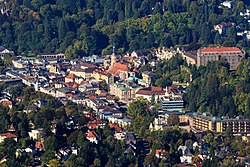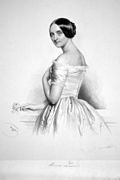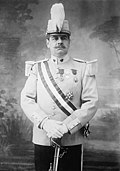Baden-Baden
Baden-Baden (Alemannic German: [Bade-Bade] Error: {{Lang}}: text has italic markup (help)) is a spa town with around 50,000 inhabitants in Baden-Württemberg, Germany. It is at the border of the Rhine valley and the Black Forest. The town is well known as a spa town, as a place for rich people and for many cultural offers. In the 19th century the town played an important role as a meeting place for the nobles, rich and other important people. A rich cultural heritage from that time can still be found at Baden-Baden.
 | |
Location of Baden-Baden
Lua error in Module:Infobox_mapframe at line 118: attempt to index field 'wikibase' (a nil value).
| |
| Coordinates: 48°45′46″N 08°14′27″E / 48.76278°N 8.24083°ECoordinates: 48°45′46″N 08°14′27″E / 48.76278°N 8.24083°E | |
| Country | Germany |
| State | Baden-Württemberg |
| Admin. region | Karlsruhe |
| District | Urban district |
| Government | |
| • Mayor | Margret Mergen (CDU) |
| Area | |
| • Total | 140.18 km2 (54.12 sq mi) |
| Elevation | 181 m (594 ft) |
| Population (2015-12-31)[1] | |
| • Total | 54,160 |
| • Density | 386.36/km2 (1,000.67/sq mi) |
| Time zone | UTC+01:00 (CET) |
| • Summer (DST) | UTC+02:00 (CEST) |
| Postal codes | 76530–76534 |
| Vehicle registration | BAD |
| Website | www |
History
The springs of Baden-Baden were known to the Romans, and the foundation of the town is referred to the emperor Hadrian by an inscription of somewhat doubtful authenticity. The name of Aurelia Aquensis was given to it in honour of Aurelius Severus, in whose reign it would seem to have been well known. Fragments of its ancient sculptures are still to be seen, and in 1847 remains of Roman vapour baths, well preserved, were discovered just below the New Castle.
In 1931, the town of Baden-Baden was officially given its double name (a short form for "Baden in Baden", i.e. Baden in the state of Baden). In both World Wars, the town escaped destruction. After World War II, Baden-Baden became the headquarters of the French forces in Germany and the site of a displaced persons camp.
From September 23 to September 28, 1981, the 11th Olympic Congress took place in the Kurhaus in Baden-Baden.
The Baden Airpark is 15 kilometres (9.3 miles) west of Baden-Baden.
The Russian writer Dostoevsky wrote "The Gambler" while gambling at the famous Baden-Baden Casino.[2]
Sights
- Kurhaus
- The Casino
- Friedrichsbad
- Caracalla Spa
- Lichtentaler Allee, a well known 19th century park
- Sammlung Frieder Burda
- Old Castle "Hohenbaden", built in 1102, the first residence of the margraves of Baden, a ruin since the 15th century
- New Castle, former residence of the margraves of Baden
- The famous Festspielhaus Baden-Baden
- Ruins of Roman baths, ca. 2000 years old, excavated in 1847
- Stiftskirche, a church including the tombs of fourteen margraves of Baden
- "The Paradise" (Paradies), an Italian style Renaissance garden with lots of trick fountains
- Mount Merkur with Merkurbergbahn funicular railway and observation tower
- Fremersberg Tower
- Fabergé Museum
- Baden-Baden
Baden-Baden Media
Antoinette Bower, 1961
References
- ↑ "Gemeinden in Deutschland nach Fläche, Bevölkerung und Postleitzahl am 30.09.2016". Statistisches Bundesamt (in German). 2016.
{{cite web}}: CS1 maint: unrecognized language (link) - ↑ "CNN Traveller in Baden-Baden". Archived from the original on 2007-12-23. Retrieved 2008-01-30.
Other websites
| Wikimedia Commons has media related to Lua error in Module:Commons_link at line 62: attempt to index field 'wikibase' (a nil value).. |
- Official site (in German and English)
- Castle Hohenbaden Archived 2007-10-27 at the Wayback Machine (in German and English)
- "Art and Nightlife Have Baden-Baden Percolating Again", New York Times, July 9, 2006


























